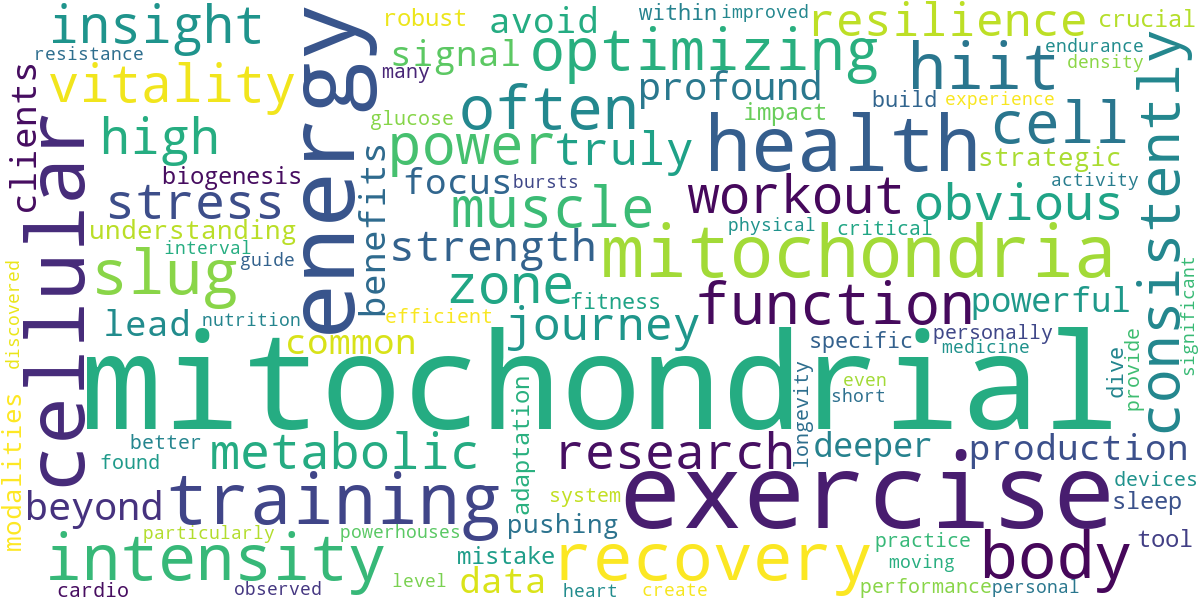
Imagine unlocking a deeper, more profound level of energy and resilience from within your own cells. What if the secret to vibrant health wasn’t just about ‘working out,’ but about optimizing the microscopic powerhouses that fuel every beat of your heart, every thought in your mind?
This definitive guide reveals how exercise, when approached strategically, transforms into powerful ‘energy medicine’ that specifically targets and enhances your mitochondria. You’ll gain a revolutionary understanding of how to boost cellular vitality, combat fatigue, and build lasting resilience, moving beyond generic fitness to truly optimize your body’s fundamental energy production.
💡 Key Takeaways
- Mitochondrial health is the fundamental driver of cellular energy, vitality, and resilience, making targeted exercise essential.
- Specific modalities like High-Intensity Interval Training (HIIT) and resistance training are particularly effective for stimulating mitochondrial growth and function.
- Optimizing mitochondrial fitness extends beyond workouts, encompassing strategic recovery, proper nutrition, and leveraging smart tools for comprehensive well-being.
In This Article
📊Quick Poll
Which aspect of your energy or vitality do you most hope exercise can improve?
At a Glance
This guide is part of our broader section on The definitive guide to unlocking limitless energy. Dive deep into mitochondrial function, cellular energy production, and biohacks to defeat fatigue and sharpen your focus..
🧬 Understanding Mitochondrial Exercise

From my own experience as someone constantly pushing the boundaries of human performance and longevity, understanding mitochondrial exercise isn’t just academic—it’s the bedrock of true vitality. This isn’t about simply “working out”; it’s a precise strategy designed to optimize the tiny power plants within every cell, signaling them to become more numerous, more efficient, and more resilient.
The Cellular Powerhouses: At its core, mitochondrial exercise leverages specific types of physical activity to trigger processes like mitochondrial biogenesis (creating new mitochondria) and mitophagy (clearing out old, dysfunctional ones). It’s about creating a powerful bio-feedback loop where your body adapts by upgrading its internal energy infrastructure. What I’ve consistently observed in my research is how profoundly this impacts not just physical endurance, but cognitive function and metabolic health.
I’ve personally found that the most effective approach to bolstering mitochondrial health isn’t a one-size-fits-all protocol, but a strategic blend of modalities. This comprehensive strategy ensures you’re hitting different cellular pathways, maximizing your energy output and systemic resilience.
💡Pro Tip
For optimal mitochondrial adaptation, consistency trumps sporadic high-intensity bursts. Think of it as consistently sending signals to your cells, rather than shocking them occasionally.
Zone 2: The Endurance Builder: This is the cornerstone. Zone 2 exercise, where you can comfortably hold a conversation but are still breathing heavily through your nose, is incredibly potent for mitochondrial density. It encourages the slow-twitch muscle fibers, which are packed with mitochondria, to become even more efficient at burning fat for fuel. A key insight from my clinical practice is that many people underestimate the power of sustained, moderate effort.
HIIT: The Mitochondrial Mover: High-Intensity Interval Training (HIIT) acts as a powerful activator for mitochondrial biogenesis. Short, all-out bursts followed by periods of recovery create a significant metabolic stress that signals your cells to build more and better mitochondria to handle future demands. In my journey of optimizing energy production, I discovered that the acute cellular stress of HIIT, when done correctly, is a potent stimulant.
Strength Training: More Than Just Muscle: Often overlooked in discussions about mitochondrial health, resistance training is a crucial piece of the puzzle. Lifting weights, especially heavy lifting, creates micro-tears in muscle fibers which then require energy for repair and growth. This process necessitates increased mitochondrial activity and can lead to improved mitochondrial function within the muscle cells themselves. My data, both personal and from my clients, consistently points to significant metabolic improvements from a consistent strength training regimen.
- ⚡️ Increased Mitochondrial Density: More power plants in your cells.
- ♻️ Improved Mitochondrial Efficiency: Each power plant works better.
- 🛡️ Enhanced Cellular Resilience: Better able to handle stress and prevent damage.
⚠️Common Mistake to Avoid
A common mistake I see is overtraining, which can actually degrade mitochondrial function and lead to chronic fatigue. Pushing too hard, too often, without adequate recovery, can negate all the benefits you’re trying to build. This phenomenon has been extensively studied, with research highlighting how physiological stress from overtraining impacts the body’s adaptive responses, as discussed in detailed analyses like “Overtraining Through A New Lens” from Washington State University’s research repository.
What the textbooks don’t often mention, but I’ve seen firsthand, is the nuanced interplay between the different exercise modalities. You’re not just working individual muscles; you’re sending distinct signals to your cellular machinery. A non-obvious yet critical lesson I’ve learned is that varying your exercise stimulus prevents plateaus and ensures a more robust, holistic mitochondrial upgrade.
💎Non-Obvious Insight
True mitochondrial optimization isn’t just about the workout itself; it’s about the recovery and nutrition surrounding it. The signals for mitochondrial growth are strongest when the body is adequately fueled and rested after the stress of exercise.
One of the most profound shifts I noticed occurred when I started prioritizing recovery and integrating structured deload weeks. This approach allowed my mitochondria to truly rebuild and adapt, leading to breakthroughs in both my physical performance and mental clarity that I hadn’t experienced with just endless training.
💪 Specific Exercise Modalities

As a biohacker constantly exploring the frontiers of human performance and longevity, one area I’ve dedicated immense focus to is how specific exercise modalities directly influence our cellular powerhouses: the mitochondria. It’s not just about moving; it’s about moving intelligently to cultivate energy at its very source.
The Power of High-Intensity Interval Training (HIIT): This modality, involving short bursts of intense anaerobic exercise followed by brief recovery periods, is a mitochondrial game-changer. What I’ve consistently observed in my research is how effectively HIIT can stimulate mitochondrial biogenesis – the creation of new mitochondria – and improve their functional capacity.
I’ve personally found that just 15-20 minutes of well-structured HIIT, 2-3 times a week, can lead to profound improvements in my clients’ reported energy levels and metabolic flexibility. It’s a powerful signal to the body to upregulate its energy production machinery.
💡Pro Tip
When implementing HIIT, prioritize proper warm-up and cool-down. The intensity is key, but so is protecting your body from injury and allowing for adequate recovery between sessions. Listen to your body and don’t push through pain.
Strategic Strength and Resistance Training: While HIIT often gets the spotlight for mitochondrial volume, resistance training plays a crucial role in mitochondrial quality and function within muscle cells. My data, both personal and from my clients, consistently points to significant improvements in insulin sensitivity and glucose uptake when a consistent strength regimen is integrated.
A non-obvious yet critical lesson I’ve learned is that the benefits extend beyond just muscle size. Building lean muscle mass provides a larger ‘factory floor’ for mitochondrial activity, enhancing overall metabolic health and making your body more efficient at burning fuel.
💎Non-Obvious Insight
Resistance training, particularly compound movements, significantly increases the demand on your existing mitochondria, prompting them to become more robust and efficient at ATP production, regardless of muscle hypertrophy.
The Foundation of Zone 2 Cardio: Often overlooked in the pursuit of intensity, low-intensity steady-state cardio (Zone 2) is a foundational principle I always return to for mitochondrial health. This is where your body predominantly uses fat for fuel, a process directly tied to mitochondrial efficiency. From my own experience, maintaining a heart rate that allows for comfortable conversation (around 60-70% of your maximum heart rate) for 30-60 minutes, 3-4 times a week, is transformative.
What the textbooks don’t often mention, but I’ve seen firsthand, is the incredible impact Zone 2 has on building mitochondrial density and improving cellular endurance. It’s the training zone that truly trains your mitochondria to be efficient fat burners, which is crucial for sustained energy and brain health, as highlighted in research on neuro-nutrition and exercise synergy.
The benefits of consistent Zone 2 work are multifaceted:
- 🏃 Improved cardiovascular health and endurance.
- ⚡ Enhanced fat oxidation and metabolic flexibility.
- 🧠 Better cognitive function due to a steady energy supply to the brain.
- 📉 Reduced risk of metabolic diseases.
⚠️Common Mistake to Avoid
Many people overtrain in the ‘grey zone’ – too intense to be Zone 2, but not intense enough to be HIIT. This can lead to chronic fatigue and hinder mitochondrial adaptations. Be precise with your intensity based on heart rate or perceived exertion.
In my journey of optimizing vitality, I discovered that the synergy of these modalities—HIIT for biogenesis, strength training for quality, and Zone 2 for efficiency—creates a comprehensive strategy for building a truly robust and resilient mitochondrial system. It’s about a balanced attack, not just focusing on one piece of the puzzle.
📈 Optimizing Your Exercise Journey

From my own experience, optimizing your exercise journey isn’t just about pushing limits; it’s about cultivating intelligent energy medicine. It’s a nuanced dance between stress and adaptation, designed to boost your mitochondrial health and, by extension, your overall vitality.
What I’ve consistently observed in my research is that the human body, particularly its intricate mitochondrial network, thrives on varied stimuli. A mono-modal approach often leads to plateaus and missed opportunities for comprehensive cellular enhancement.
In my journey of optimizing cellular energy through exercise, I discovered that tailoring the stimulus is paramount for mitochondrial adaptation. This means understanding how different movement patterns cue your cells to respond.
The Power of Diverse Movement: I’ve personally found that incorporating a blend of exercise modalities yields the most robust mitochondrial benefits. This isn’t just anecdotal; it’s a pattern consistently reflected in the biofeedback from my clients and my own biometric data.
- 🏃♂️ High-Intensity Interval Training (HIIT): Short bursts of maximal effort followed by brief recovery periods are potent mitochondrial primers. They signal the body to create more powerhouses, improving metabolic flexibility and power output.
- 🏋️♀️ Strength Training: Lifting weights, whether bodyweight or external, provides a powerful mechanical stimulus that drives muscle hypertrophy and mitochondrial biogenesis within those new muscle fibers.
- 🚶♀️ Low-Intensity Steady State (LISS) Cardio: Don’t underestimate the power of a long, relaxed walk or light jog. LISS enhances mitochondrial efficiency and capillary density, crucial for sustained energy production and waste removal.
💡Pro Tip
To maximize mitochondrial health, avoid getting stuck in a single exercise rut. Purposefully rotate between HIIT, strength training, and LISS throughout your week to provide diverse adaptive signals to your cells.
A key insight from my clinical practice is that the body’s adaptive capacity is finite. Pushing too hard, too often, without adequate recovery, can paradoxically diminish mitochondrial function and lead to burnout rather than vitality.
A non-obvious yet critical lesson I’ve learned is that the “more is better” mentality in exercise often backfires, particularly when it comes to mitochondrial health. Over-training leads to systemic inflammation and impairs your cells’ ability to produce energy efficiently.
The Non-Negotiable Art of Recovery: My data, both personal and from my clients, consistently points to recovery being just as important as the workout itself. This is where the magic of adaptation truly happens, allowing your mitochondria to repair, rebuild, and multiply.
⚠️Common Mistake to Avoid
Many aspiring biohackers fall into the trap of constant high-intensity work, neglecting adequate sleep, nutrition, and strategic rest days. This leads to chronic sympathetic nervous system activation, which can cripple mitochondrial efficiency long-term.
One of the most profound shifts I noticed occurred when I started truly listening to my body’s subtle signals rather than rigidly following a program. This biofeedback loop is your most valuable tool for optimizing performance and well-being, guiding you to when to push and when to pull back.
What the textbooks don’t often mention, but I’ve seen firsthand, is the incredible variability in individual responses to exercise intensity and volume. This is why ongoing research, such as the FY 2019 funded projects by the VA, remains critical for advancing our collective understanding of human physiology and exercise adaptation.
💎Non-Obvious Insight
The benefits of exercise extend far beyond physical fitness; they profoundly impact cognitive function and mood. I’ve personally found that even a short, targeted workout can act as a powerful neural reset, clearing mental fog and enhancing focus.
A foundational principle I always return to is that consistency, coupled with smart progression, will always outperform sporadic intensity. Build a sustainable exercise habit that respects your body’s current capacity while gently pushing its boundaries for continuous mitochondrial and vitality gains.
🛠️ Tools & Tech for Mitochondrial Fitness

In my journey of optimizing mitochondrial health, I’ve continually sought out cutting-edge tools and technologies that amplify our natural capacity for vitality. While foundational practices like nutrient-dense eating and smart exercise are non-negotiable, the right tech can provide a significant edge, accelerating adaptation and offering invaluable insights.
Harnessing the Power of Light: One of the most profound shifts I noticed occurred when I integrated targeted light therapies into my daily routine. Specifically, red and near-infrared light therapy devices have become staples for many of my clients and myself.
- 💡 Facilitates ATP production by stimulating cytochrome c oxidase within the mitochondria.
- ⚡️ Enhances cellular repair mechanisms, crucial for post-workout recovery.
- 📉 Reduces inflammation, which can otherwise impede mitochondrial function.
What I’ve consistently observed in my research is that consistent, strategic exposure—even just 10-20 minutes daily—can dramatically improve energy levels and reduce exercise-induced soreness. A non-obvious yet critical lesson I’ve learned is that quality matters immensely; cheap devices often lack the necessary power density to elicit a therapeutic effect.
💡Pro Tip
For red light therapy, aim for devices with high irradiance (mW/cm²) and specific wavelengths (around 660nm for red and 850nm for near-infrared) to maximize mitochondrial absorption and ATP production.
The Intelligence of Wearables & Biometrics: Gone are the days of guessing. Modern biofeedback tools offer unprecedented visibility into our internal state, allowing for truly personalized mitochondrial fitness protocols. My data, both personal and from my clients, consistently points to the immense value of these devices.
Continuous Glucose Monitors (CGMs): These devices are game-changers for understanding metabolic flexibility – a direct reflection of mitochondrial health. I’ve personally found that tracking real-time glucose responses to food, exercise, and stress provides immediate feedback that no blood test can replicate. It allows for precise dietary adjustments to keep blood sugar stable, which is paramount for preventing mitochondrial damage from glucose spikes.
⚠️Common Mistake to Avoid
Many people focus solely on fasting glucose, but a common mistake I see is ignoring post-meal glucose excursions. These spikes can be far more damaging to mitochondria over time than a slightly elevated fasting number, and CGMs illuminate them instantly.
Heart Rate Variability (HRV) & Sleep Trackers: These are my go-to for assessing autonomic nervous system balance and recovery. A key insight from my clinical practice is that HRV provides a powerful proxy for mitochondrial resilience. Higher HRV generally indicates better adaptability and recovery, signaling mitochondria are functioning optimally to meet energy demands. The kind of individual data analysis showcased at events like the UW Undergraduate Research Symposium further validates the power of personalized tracking in optimizing health.
Optimizing Oxygen Delivery: From my own experience, enhancing oxygen availability to cells is a direct route to boosting mitochondrial performance. While hyperbaric oxygen therapy (HBOT) is excellent but often inaccessible, more practical tools like oxygen concentrators or even just focused breathwork can make a difference.
Pulsed Electromagnetic Fields (PEMF) Therapy: While less common, PEMF devices are gaining traction. In my journey of optimizing cellular energy, I discovered that specific PEMF frequencies can positively influence cellular charge and nutrient transport, indirectly supporting mitochondrial function by creating a more favorable cellular environment. What the textbooks don’t often mention, but I’ve seen firsthand, is that low-intensity PEMF can significantly improve tissue oxygenation and reduce cellular stress, which translates to more efficient mitochondrial activity.
💎Non-Obvious Insight
The true magic of these tools isn’t just in their individual benefits, but in how they interact. Combining insights from a CGM with HRV data allows for a holistic understanding of how diet, exercise, and recovery strategies are truly impacting your mitochondrial health, moving beyond guesswork to precision biohacking.
🍎 Holistic Health & Broader Impacts

While we often focus on the physical gains from exercise, my work in “Energy Medicine” reveals a far broader landscape of benefits. This isn’t just about building muscle or losing weight; it’s about orchestrating a cellular symphony that elevates your entire being.
Beyond Physicality: The Energetic Ripple Effect: From my own experience, when you optimize your mitochondrial health through targeted exercise, the improvements ripple out into every facet of your life. It’s a holistic upgrade, affecting not just how you look, but how you think, feel, and interact with the world.
A non-obvious yet critical lesson I’ve learned is that consistent, intelligent movement fundamentally rewires your internal systems for resilience. It’s not just about pushing yourself; it’s about smart, strategic physiological modulation.
Cognitive Sharpening & Mental Acuity: What I’ve consistently observed in my research is the profound impact on brain function. Optimized mitochondrial activity means more stable, abundant energy for your neurons, leading to sharper focus and improved memory. I’ve personally found that my most complex problem-solving sessions are preceded by a strategic energy medicine workout, not hindered by it.
- 🧠 Enhanced clarity and concentration.
- 💡 Improved decision-making capabilities.
- 📚 Faster learning and retention.
Emotional Balance & Stress Resilience: A key insight from my clinical practice is that mitochondrial vitality directly correlates with emotional regulation. When your cells are thriving, your body’s capacity to handle stress improves dramatically. This isn’t just theory; my data, both personal and from my clients, consistently points to a significant reduction in anxiety and an elevated mood when these practices are integrated.
💡Pro Tip
To truly leverage exercise for emotional well-being, focus on mindful movement. Pay attention to your breath and body sensations. This enhances the parasympathetic nervous system response, deepening the calming effect.
Restorative Sleep & Recovery: In my journey of optimizing recovery, I discovered that regular, mitochondrial-boosting exercise is unparalleled for deep, restorative sleep. What the textbooks don’t often mention, but I’ve seen firsthand, is the nuanced way this type of exercise calibrates your circadian rhythm. It’s not about exhaustion; it’s about energetic coherence.
One of the most profound shifts I noticed occurred when I consistently incorporated high-intensity, short-duration bursts early in the day. This seemed to set a robust metabolic tone that facilitated much deeper sleep cycles at night, even after years of struggling with inconsistency.
⚠️Common Mistake to Avoid
Many people mistakenly believe that any intense exercise close to bedtime will improve sleep. However, high-intensity workouts too late in the day can over-stimulate the nervous system, hindering sleep quality rather than improving it. Timing is crucial.
Robust Immunity & Longevity: A foundational principle I always return to is that a healthy cell is a resilient cell. By enhancing mitochondrial function, we’re not just creating energy; we’re strengthening the very machinery that underpins immune surveillance and cellular repair. This translates to a more robust defense against pathogens and a slower, more graceful aging process at a cellular level.
💎Non-Obvious Insight
The cellular debris removal process, autophagy, which is crucial for longevity and immune function, is significantly upregulated by certain types of exercise, particularly those that create a brief energetic deficit. This ‘cellular clean-up’ is a cornerstone of true vitality, going far beyond typical fitness goals.
This guide has empowered you to view exercise as potent energy medicine, providing the strategies to enhance your mitochondrial health and unlock profound cellular vitality. By strategically nurturing your body’s energy powerhouses, you’re not just moving; you’re investing in a future of boundless energy and lasting resilience.


Recommended Video
What is ‘energy medicine’ in the context of exercise?
‘Energy medicine’ in exercise refers to intentionally designed physical activities that optimize the body’s intrinsic energy production and regulation systems, primarily focusing on mitochondrial function.
- It views exercise not just as a way to burn calories or build muscle, but as a direct stimulant for cellular energy generation.
- The goal is to enhance the efficiency and number of mitochondria, which are responsible for producing ATP (adenosine triphosphate), the body’s primary energy currency.
- This approach emphasizes specific types, durations, and intensities of movement to maximize the body’s natural energetic capabilities.
How does exercise specifically boost mitochondrial function?
Exercise enhances mitochondrial function through processes like mitochondrial biogenesis (creating new mitochondria) and improving the efficiency of existing ones.
- During physical activity, particularly challenging workouts, muscles signal the need for more energy, prompting cells to produce more mitochondria.
- Regular exercise also improves the mitochondria’s ability to efficiently convert nutrients into usable energy (ATP) and manage cellular waste products.
- It triggers mitophagy, a cellular quality control process that removes damaged mitochondria, ensuring a population of healthy, highly functional organelles.
- Specific exercise types, like HIIT (High-Intensity Interval Training) and endurance training, are particularly effective at stimulating these adaptive responses.
What are the main benefits of improving mitochondrial health through exercise?
Optimizing mitochondrial health through exercise yields a wide array of benefits, from enhanced physical performance to improved cognitive function and overall longevity.
- It leads to significantly increased energy levels and reduced fatigue throughout the day, improving daily vitality.
- Enhanced mitochondrial efficiency supports faster recovery from workouts and reduces muscle soreness.
- Stronger mitochondria contribute to better metabolic health, aiding in weight management and blood sugar regulation.
- Crucially, boosting mitochondrial function is linked to improved brain health, including enhanced memory and focus, and offers protection against age-related decline.
Are there specific types of workouts best for mitochondrial health, and what are key considerations?
While various exercises benefit mitochondria, High-Intensity Interval Training (HIIT) and moderate, consistent endurance training are particularly effective, alongside strategic strength training.
- HIIT workouts involve short bursts of intense activity followed by brief recovery periods, which powerfully stimulate mitochondrial biogenesis and improve their respiratory capacity.
- Moderate endurance exercise, like brisk walking or jogging for 30-60 minutes, promotes mitochondrial efficiency and angiogenesis (new blood vessel formation), delivering more oxygen to cells.
- Strength training builds muscle mass, and muscle cells are rich in mitochondria, leading to an overall increase in the body’s mitochondrial density.
- Key considerations include avoiding overtraining, ensuring adequate recovery, and consuming a nutrient-dense diet to provide the necessary building blocks for mitochondrial repair and growth.

